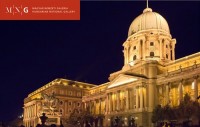Adolf Fényes was one of the decisive figures of the artists’ colony of Szolnok that was established in 1902. In his period between 1897 and 1908, he painted his series Life of the Poor with deep commitment and empathy. The genre scenes of the cycle divide into three distinct stylistic groups. In the realistic works of the initial years, the dramatic character of the monumental peasant figures is enhanced by the use of dark brown and black colours. From 1903, his palette brightened, while the motifs were soaked in sunlight and eventually, he arrived at a post-impressionist approach to the picture. In Siblings, decorative forms bring forth the figures of the figures against a homogeneous blue background. In the works of this period, Fényes usually depicted one typical figure or typical moment. The concise indication of the interior allows a glimpse of the everyday life of the poor peasantry, of their simple but noble material culture. The noted art writer of the period Károly Lyka wrote about Fényes’ paintings in 1905: “He achieves increasingly more with increasingly less.”
en

